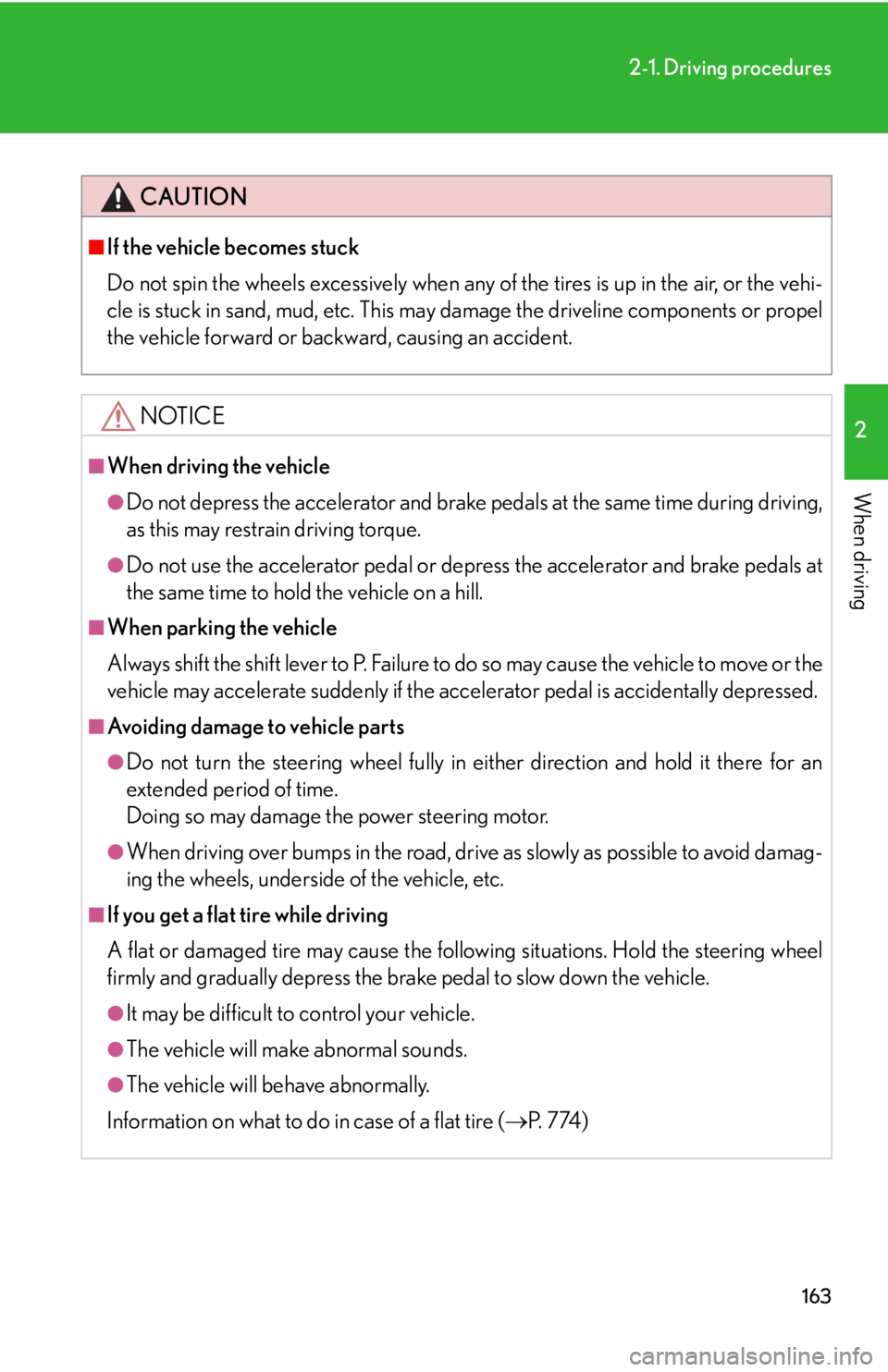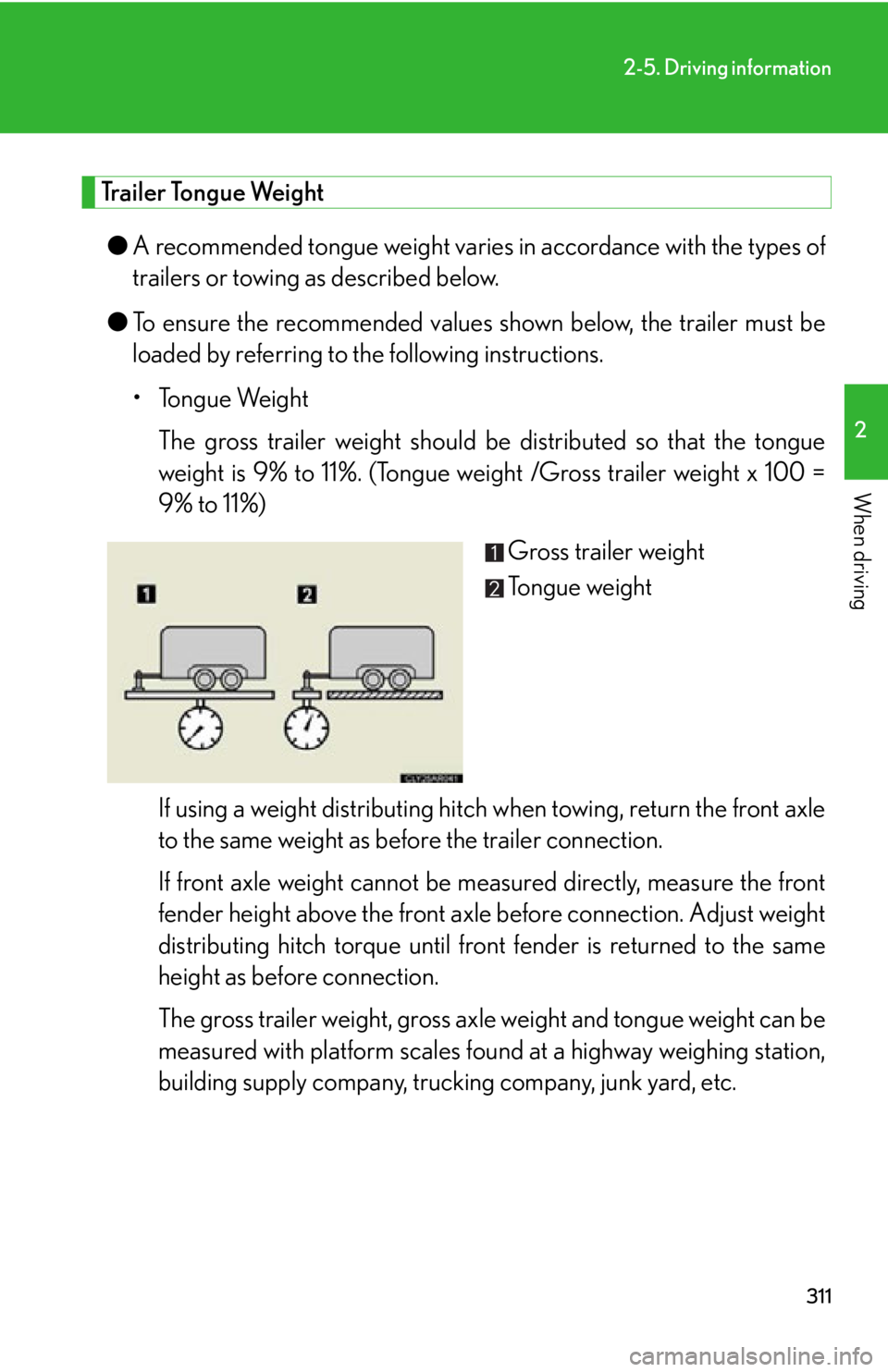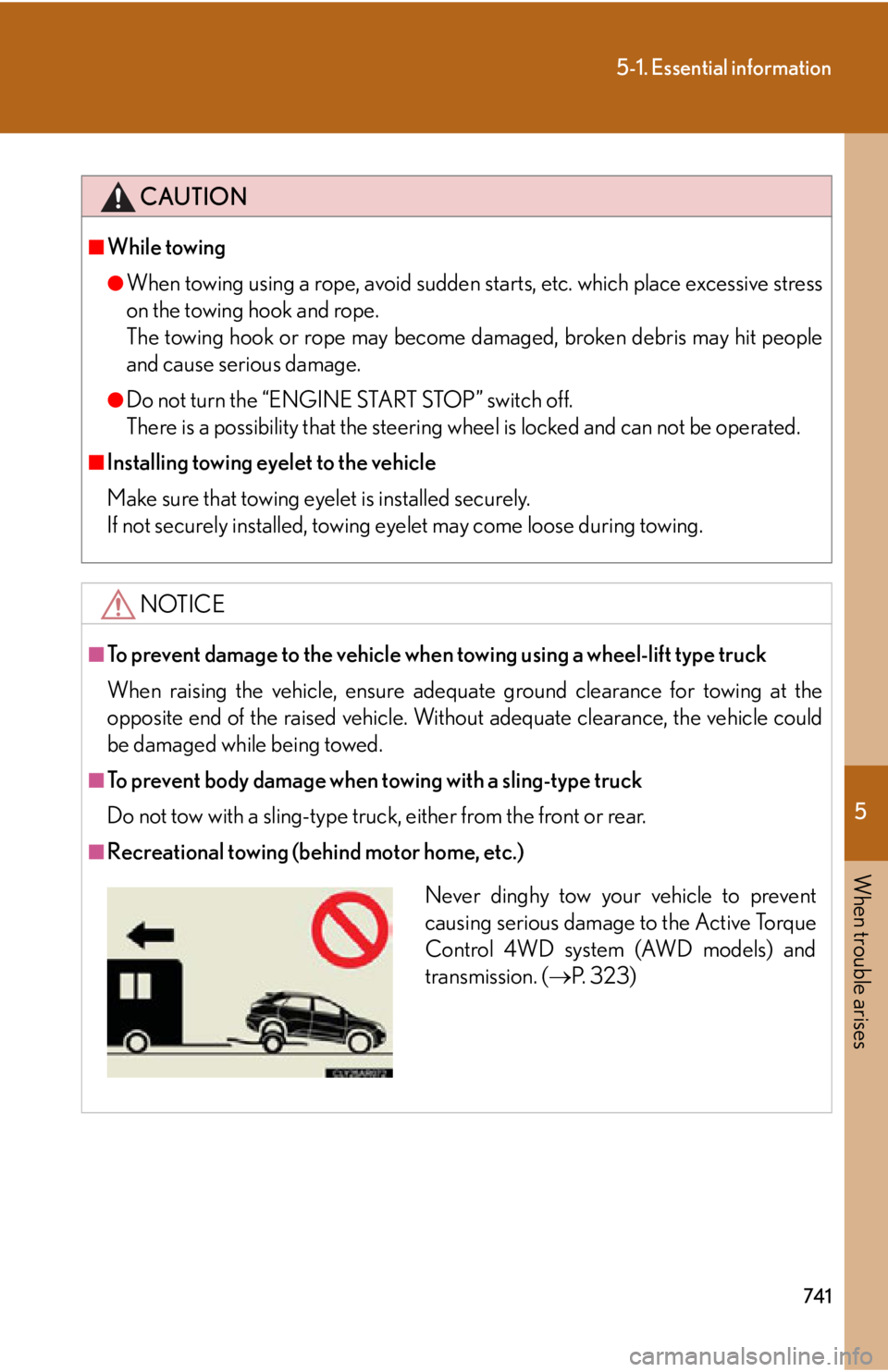Page 163 of 886

1632-1. Driving procedures
2
When driving CAUTION■
If the vehicle becomes stuck
Do not spin the wheels excessively when any of the tires is up in the air, or the vehi-
cle is stuck in sand, mud, etc. This may damage the driveline components or propel
the vehicle forward or backward, causing an accident.
NOTICE■
When driving the vehicle ●
Do not depress the accelerator and brake pe dals at the same time during driving,
as this may restrain driving torque.●
Do not use the accelerator pedal or depress the accelerator and brake pedals at
the same time to hold the vehicle on a hill.■
When parking the vehicle
Always shift the shift lever to P. Failure to do so may cause the vehicle to move or the
vehicle may accelerate suddenly if the accel erator pedal is accidentally depressed.■
Avoiding damage to vehicle parts ●
Do not turn the steering wheel fully in either direction and hold it there for an
extended period of time.
Doing so may damage the power steering motor.●
When driving over bumps in the road, drive as slowly as possible to avoid damag-
ing the wheels, underside of the vehicle, etc. ■
If you get a flat tire while driving
A flat or damaged tire may cause the following situations. Hold the steering wheel
firmly and gradually depress the brak e pedal to slow down the vehicle.●
It may be difficult to control your vehicle.
●
The vehicle will make abnormal sounds.
●
The vehicle will behave abnormally.
Information on what to do in case of a flat tire ( P. 7 74 )
Page 269 of 886

2692-4. Using other driving systems
2
When driving Driving assist systems To help enhance driving safety and performance, the following systems
operate automatically in response to various driving situations. Be aware,
however, that these systems are supplementary and should not be relied
upon too heavily when operating the vehicle.
■ ABS (Anti-lock Brake System) Helps to prevent wheel lock when the brakes are applied suddenly, or if
the brakes are applied while driving on a slippery road surface
■ Brake assist Generates an increased level of braking force after the brake pedal is
depressed, when the system detects a panic stop situation
■ VSC (Vehicle Stability Control) Helps the driver to control skidding when swerving suddenly or turning on
slippery road surfaces
■ TRAC (Traction Control) Helps to maintain drive power and prevent the drive wheels from spinning
when starting the vehicle or accelerating on slippery roads
■ Hill-start assist control P. 2 76
■ EPS (Electric Power Steering) Employs an electric motor to reduce the amount of effort needed to turn
the steering wheel
■ Active Torque Control 4WD system (AWD models) Automatically switches from front-wheel drive to AWD (All-Wheel Drive)
according to driving conditions, help ing to ensure reliable handling and
stability. Examples of conditions wher e the system will switch to AWD are
when cornering, going uphill, starti ng off or accelerating, and when the
road surface is slippery due to snow or rain etc.
Page 275 of 886
2752-4. Using other driving systems
2
When driving All-wheel drive lock switch (AWD models)
■
All-wheel drive lock mode ●
All-wheel drive lock mode is canceled when the brakes are applied to ensure
the ABS and VSC systems operate effectively.●
All-wheel drive lock mode is canceled when the vehicle speed exceeds 25 mph
(40 km/h).All-wheel drive lock mode can be used when a large amount of drive power
needs to be applied to all the wheels, such as when the vehicle gets stuck in
mud and you need to free it.
Press the switch. The torque of the engine is dis-
tributed to the rear wheels to
the maximum extent possible in
accordance with driving condi-
tions.
Pressing the switch again can-
cels all-wheel drive lock mode
and returns the active torque
control 4WD system to normal
mode. ( P. 2 6 9 )
Page 311 of 886

3112-5. Driving information
2
When driving Trailer Tongue Weight
● A recommended tongue weight varies in accordance with the types of
trailers or towing as described below.
● To ensure the recommended values shown below, the trailer must be
loaded by referring to the following instructions.
• Tongue Weight
The gross trailer weight should be distributed so that the tongue
weight is 9% to 11%. (Tongue weight /Gross trailer weight x 100 =
9% to 11%)
Gross trailer weight
Tongue weight
If using a weight distri buting hitch when towing , return the front axle
to the same weight as before the trailer connection.
If front axle weight cannot be mea sured directly, measure the front
fender height above the front axle before connection. Adjust weight
distributing hitch torque until fr ont fender is returned to the same
height as before connection.
The gross trailer weight, gross axle weight and tongue weight can be
measured with platform scales foun d at a highway weighing station,
building supply company, truck ing company, junk yard, etc.
Page 323 of 886
3232-5. Driving information
2
When driving Dinghy towing NOTICE■
To avoid serious damage to your vehicle
■
To prevent causing serious damage to th e transmission and Active Torque Con-
trol 4WD system (AWD models)Your vehicle is not designed to be dinghy towed (with 4 wheels on the
ground) behind a motor home.
Do not tow your vehicle with four wheels on
the ground.
2WD models: Never tow this vehicle from
the rear with the front wheels on the ground.
This may cause serious damage to the trans-
mission.
AW D m o d e l s : N e v e r t o w this vehicle with
any of the wheels on the ground. This may
cause serious damage to the transmission
and Active Torque Control 4WD system.
Page 741 of 886

5
When trouble arises
7415-1. Essential information
CAUTION■
While towing ●
When towing using a rope, avoid sudden starts, etc. which place excessive stress
on the towing hook and rope.
The towing hook or rope may become damaged, broken debris may hit people
and cause serious damage.●
Do not turn the “ENGINE START STOP” switch off.
There is a possibility that the steering wheel is locked and can not be operated.■
Installing towing eyelet to the vehicle
Make sure that towing eyelet is installed securely.
If not securely installed, towing eyelet may come loose during towing.
NOTICE■
To prevent damage to the vehicle when towing using a wheel-lift type truck
When raising the vehicle, ensure adequa te ground clearance for towing at the
opposite end of the raised vehicle. Without adequate clearance, the vehicle could
be damaged while being towed.■
To prevent body damage when to wing with a sling-type truck
Do not tow with a sling-type truck, either from the front or rear.■
Recreational towing (behind motor home, etc.)
Never dinghy tow your vehicle to prevent
causing serious damage to the Active Torque
Control 4WD system (AWD models) and
transmission. ( P. 323)
Page 783 of 886
5
When trouble arises
7835-2. Steps to take in an emergency
Lower the vehicle.
Firmly tighten each wheel nut two
or three times in the order shown
in the illustration. Tightening torque:
76 ft•lbf (103 N•m, 10.5 kgf•m)
Stow the flat tire, tire jack and all tools.STEP 3
STEP 4
■
The compact spare tire ●
The compact spare tire is identified by the label “TEMPORARY USE ONLY”
on the tire sidewall.
Use the compact spare tire temporarily, and only in an emergency.●
Make sure to check the tire inflatio n pressure of the compact spare tire.
( P. 815)■
When using the compact spare tire
As the compact spare tire is not equipped with a tire pressure warning valve and
transmitter, low inflation pressure of the spare tire will not be indicated by the tire
pressure warning system. Also, if you repl ace the compact spare tire after the tire
pressure warning light comes on, the light remains on. STEP 5
Page 817 of 886
8156-1. Specifications
6
Vehicle specifications Tires and wheels
Type A
Type BTi r e s i z e P235/60R18 102V, T165/90D18 107M (spare)
Tire inflation pressure
(recommended cold tire
inflation pressure) Driving under normal conditions
Front:
32 psi (220 kPa, 2.2 kgf/cm 2
or bar)
Rear:
32 psi (220 kPa, 2.2 kgf/cm 2
or bar)
Spare:
60 psi (420 kPa, 4.2 kgf/cm 2
or bar)
Wheel size 18 7 1 /2J, 18 4T (spare)
Wheel nut torque 76 ft•lbf (103 N•m, 10.5 kgf•m)
Ti r e s i z e P235/60R18 102V
Tire inflation pressure
(recommended cold tire
inflation pressure) Driving under normal conditions
Front:
32 psi (220 kPa, 2.2 kgf/cm 2
or bar)
Rear:
32 psi (220 kPa, 2.2 kgf/cm 2
or bar)
Spare:
32 psi (220 kPa, 2.2 kgf/cm 2
or bar)
Wheel size 18 7 1 /2J
Wheel nut torque 76 ft•lbf (103 N•m, 10.5 kgf•m)